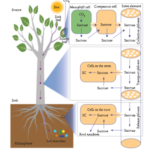Biological Parts for Plant Biodesign to Enhance Land-Based Carbon Dioxide Removal
Abstract
A grand challenge facing society is climate change caused mainly by rising CO2 concentration in Earth’s atmosphere. Terrestrial plants are linchpins in global carbon cycling, with a unique capability of capturing CO2 via photosynthesis and translocating captured carbon to stems, roots, and soils for long-term storage. However, many researchers postulate that existing land plants cannot meet the ambitious requirement for CO2 removal to mitigate climate change in the future due to low photosynthetic efficiency, limited carbon allocation for long-term storage, and low suitability for the bioeconomy. To address these limitations, there is an urgent need for genetic improvement of existing plants or construction of novel plant systems through biosystems design (or biodesign). Here, we summarize validated biological parts (e.g., protein-encoding genes and noncoding RNAs) for biological engineering of carbon dioxide removal (CDR) traits in terrestrial plants to accelerate land-based decarbonization in bioenergy plantations and agricultural settings and promote a vibrant bioeconomy. Specifically, we first summarize the framework of plant-based CDR (e.g., CO2 capture, translocation, storage, and conversion to value-added products). Then, we highlight some representative biological parts, with experimental evidence, in this framework. Finally, we discuss challenges and strategies for the identification and curation of biological parts for CDR engineering in plants.
Learn about our two Decals!
 Click here to find out more about our Fall Bioinspired Design Decal and our Spring Bioinspired Design in Action Decal – ALL MAJORS are welcome.
Click here to find out more about our Fall Bioinspired Design Decal and our Spring Bioinspired Design in Action Decal – ALL MAJORS are welcome.Berkeley BioDesign Community
 Click here to learn about the BioD: Bio-Inspired Design @ Berkeley student organization or here to signup for more info.
Click here to learn about the BioD: Bio-Inspired Design @ Berkeley student organization or here to signup for more info.Search
Student Login




I imagine that the neurological circuits underlying these processes are governed by both 2d spacing maps with their brains as…
to reduce the impact of car accidents, it may be possible to study the force diverting physics of cockroaches to…
you see this type of head-bobbing stability in many avian creatures related to pigeons like chickens. the head ability to…
not like they taught horses how to run! this is an example of convergent evolution where both sea creatures and…
The brain functions in a similar way with neuronal connections. our brains are able to utilize the multiplicity of connections…